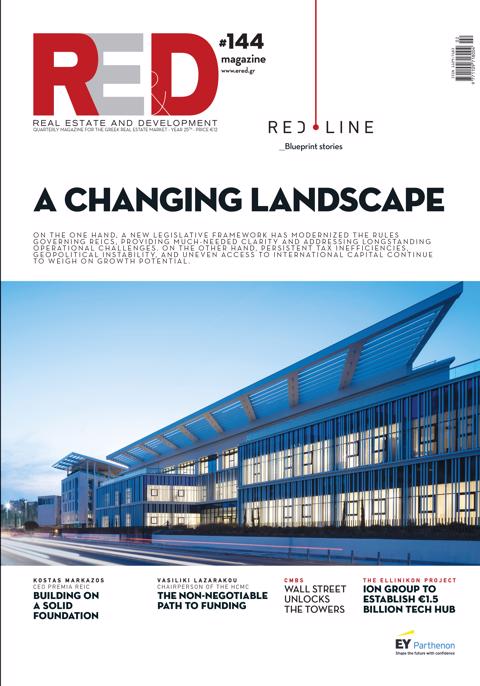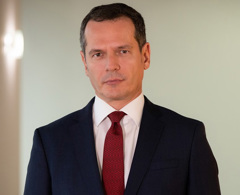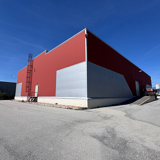Members of the European Construction Industry Federation (FIEC), along with prominent figures from around the world, gathered recently in Athens, as the Panhellenic Association of Civil Engineering Contractors (PEDMEDE) hosted the annual pan-European FIEC conference. This year’s theme was “Building Tomorrow: Solutions for Water Resilience and Blue Infrastructure.” The FIEC General Assembly was also held in Athens.
Mr. Petroutsos addresses the concern whether existing and planned infrastructure will ultimately be capable of withstanding the (currently unknown) consequences and impacts of the climate crisis, as well as whether national economies and the EU can manage the continuously rising costs associated with this challenge.
He explains how the necessary modernization of infrastructure can—and must—be implemented to ensure proper water management and flood protection. He also refers to specific initiatives, solutions, and proposals to tackle the housing crisis affecting all of Europe.
Interview with APE-MPE
- At your annual conference, it was highlighted that the European construction industry possesses the expertise to develop solutions that provide essential services addressing water-related challenges. Could you elaborate on this?
What we discussed—together with members, speakers, and guests—at the FIEC Annual Conference on May 16 at the Stavros Niarchos Foundation Cultural Center in Athens, is that the construction industry is indispensable for building real, sustainable solutions to Europe’s growing water challenges. Floods, droughts, and water pollution are already severely impacting citizens and economies. Our sector holds the expertise to act. We are the ones who construct and maintain the infrastructure ensuring water treatment, distribution, storage, and flood protection. With over 6.5 billion cubic meters of water lost annually in the EU—due to poorly maintained pipes and extreme weather—resilient infrastructure is not an option but an urgent necessity. The time to act is now. As the EU prepares its Water Resilience Strategy and places water at the core of its political agenda, it is clear the construction sector will play a vital role in realizing these ambitions. When we say the construction sector "builds the change," we mean it literally. Without the involvement of our members, companies, service providers, and contractors, no water resilience strategy can succeed.
- Many argue that even projects currently being planned—and to be constructed in coming years—may not meet future demands, since it is difficult (if not impossible) to predict the consequences of the climate crisis. What is your view on this?
To build resilient water infrastructure that is “fit for purpose,” we must do our best to anticipate future demands. This is no easy task, but the availability of comprehensive data helps align projections with realistic future scenarios regarding regional water needs. The European Construction Industry Federation thus calls for improved network monitoring through new technologies like smart metering and continuous digital data availability. In-depth knowledge of the network is key to prioritizing effective and timely maintenance and renewal of existing water distribution systems.
A dedicated EU Water Fund should be part of the upcoming Multiannual Financial Framework to co-finance network monitoring and digitization, aiming to make smart meters and sensors the standard.
- Many also argue that adapting to the climate crisis could be prohibitively expensive, beyond the capacity of national economies or the EU to bear. What is your response?
It’s true that climate adaptation entails significant costs. However, from our perspective, these costs are not just necessary but increasingly inevitable. We are already witnessing the impacts of more frequent extreme weather events such as floods, droughts, and coastal erosion. These put unprecedented strain on existing hydraulic infrastructure, which was not designed for today’s or future scenarios. Upgrading and future-proofing this infrastructure is a matter of resilience and risk mitigation. Financial pressure affects both public and private sectors alike. Insurance costs for buildings and infrastructure are rising due to climate risks, and service interruptions are increasing. In some regions, insurance has even become unavailable. This alone presents a strong economic case for investing now in climate-resilient infrastructure such as stormwater retention, flood protection, and smarter, more flexible water distribution networks.
- Mr. Petroutsos, let’s turn to another issue concerning smaller-scale construction: housing costs have skyrocketed across Europe, leading to a housing crisis. The EU is seeking solutions. What is the construction industry’s stance? How can the housing crisis be resolved?
Across Europe, housing costs have indeed reached a breaking point. This is not a demand crisis but a supply crisis. We are not building (or renovating) enough residential units where citizens need them most. We welcome the fact that European Commission President Ursula von der Leyen has prioritized this crisis by appointing, for the first time, a dedicated Commissioner for Housing Policy—a very positive step. It is also encouraging that the recently approved Cohesion Policy reform, led by Vice-President Raffaele Fitto, places strong emphasis on this issue, which represents one of the most urgent and complex social and economic challenges in Europe. We remain optimistic as the urgency to address this crisis is now broadly recognized.
From the construction sector’s perspective, FIEC aims to tackle multiple factors driving construction costs. At all levels—global, European, national, and local—we face regulatory burdens, slow administrative processes, industrial shortages, lack of skilled labor and land, and challenging access to financing.
Regarding solutions, there is no magic bullet. Different local challenges require different responses. Clearly, we can boost sector productivity through digitization, innovation, standardization, and circularity of raw materials, but these require investments. We need increased support from EU funds and EIB financing instruments. We also need easier lending frameworks for housing construction projects, through greater flexibility from the European Central Bank and Basel regulatory rules, which currently classify housing construction as high risk. Regarding the EU, it can act within its competencies by simplifying legislation impacting construction costs and procedures, and similarly streamline legislation with indirect effects on spatial planning and permitting at national and local levels. While the EU cannot force Member States to act, it can propose recommendations and guidelines based on common best practices.
- One last question: since much of Europe’s housing stock is old and costly to renovate to “green” standards, do you think subsidy policies (for materials and services) can help? Or should we consider a global (or even pan-European) agreement to reduce prices of building materials? How do you assess the EU’s approach so far?
I believe the various incentive policies—including subsidies and fiscal advantages—adopted by Member States have proven quite effective. Indeed, renovation is costly and administrative procedures lengthy. I think subsidies should target an overall renovation goal rather than specific materials or services. This renovation target has been set at EU level at at least 2% (current annual rate is below 1%). About 70% of the EU building stock is energy inefficient, and renovation rates must accelerate to meet energy reduction targets for heating and cooling. However, the main challenge with energy-efficient renovations is the high upfront investment cost. Even when energy savings pay off after several years, the initial cost remains a key deterrent for households. Innovative financing and risk-sharing models could therefore be part of the solution.















